Agrius cingulata
|
|
Updated as per More, Kitching and Cocucci's Hawkmoths of Argentina 2005, October, 2007
Updated as per All Leps Barcode of Life, October, 2007
Updated as per http://www.pybio.org/SPHINGINAE.htm (Paraguay), October 2007
Updated as per http://biological-diversity.info/sphingidae.htm (Belize), October 2007
Updated as per Fauna Entomologica De Nicarauga, November 2007
Updated as per Sphingidae (Lepidoptera) de Venezuela, Compilado por: María Esperanza Chacín; December 2009
Updated as per personal communication with Leif Gabrielsen (Bella Vista Lodge, Pichincha, Ecuador, October 19, 2009); December 2009
Updated as per personal communication with Ezequiel Nunez Bustos (Osununu Private Reserve, Misiones, Argentina, November 24, 2009); December 2009
Updated as per personal communication with Larry Valentine (Itanhandu, southern Minas Gerais, Brazil, November 8, 2009): January 1, 2010
Updated as per French Guiana Sphingidae; March 9, 2011
Updated as per personal communication with Paul Hoekstra (Yucatan, Mexico, August 17, 2011); October 2, 2011
Updated as per personal communication with Ed and Jan Sakoda, (Laie, Honolulu County, Oahu, Hawaii, March 4, 2012); March 5, 2012
Updated as per personal communication with Lorna MacLean, (Sydney, Cape Breton Island, Nova Scotia, September 30, 2012); October 1, 2012
Updated as per "A Hawk Moths fauna of southern Maranhão state, Brazil, ... "; NEVA: Jahrgang 34 Heft 3 November 2013; via Jean Haxaire; April 5, 2014
Updated as per personal communication with Hubert Mayer (La Union del Toachi, Pichincha, Ecuador, November, 1988); June 3, 2014
Updated as per personal communication with Robert Oswald, (Kahului, Maui, Hawaii, July 13, 2014); July 15, 2014
Updated as per personal communication with Sergio D. Ríos Díaz in CATÁLOGO DE LOS SPHINGIDAE (INSECTA: LEPIDOPTERA) DEPOSITADOS EN
EL MUSEO NACIONAL DE HISTORIA NATURAL DEL PARAGUAY; sent to me in July 2014 by Sergio D. Ríos Díaz.
Updated as per personal communication with Joanna Rodriguez Ramirez (Chaco; Corrientes; Formosa; Argentina), January 21, 2015
Updated as per personal communication with Deanna H., via Daniel Marlos (mature larva; July 31, 2015; Pearl Harbor, Oahu, Hawaii), August 3, 2015
Updated as per personal communication with Ezequiel Bustos (Shilap revta. lepid. 43 (172) diciembre, 2015, 615-631 eISSN 2340-4078 ISSN 0300-5267), January 4, 2016
Updated as per personal communication with Francierlem Oliveira (Extremoz, Rio Grande do Norte, Brazil), November 6, 2016
Updated as per personal communication with Derek Bridgehouse (Metcalfe County, Kentucky, July 17, 2013); April 12, 2017
Updated as per personal communication with Renato Mattei (Puerto Ayacucho, Amazonas, Venezuela, August 19, 2018); August 19, 2019
Updated as per personal communication with Frank West (Guatemala, Peru, Brazil); January 15, 2021
|
Agrius cingulata
ah-GREE-usM sin-gue-LAY-ta
The Pink-spotted Hawkmoth
(Fabricius, 1775) Sphinx
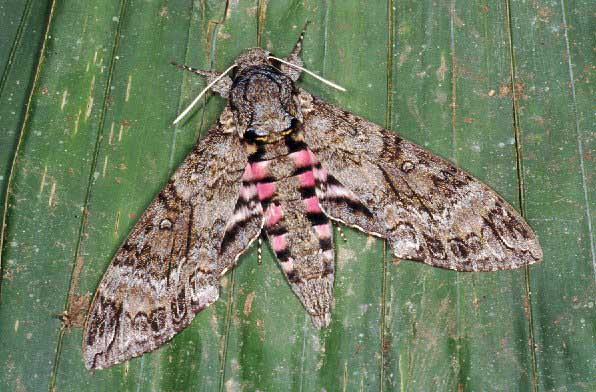
Agrius cingulata from Rancho Grande, H. Pittier National Park, Venezuela,
courtesy of Paolo Mazzei.
This site has been created by Bill Oehlke. Comments, suggestions and/or additional information are welcomed by Bill.
TAXONOMY:
Family: Sphingidae, Latreille, 1802
Subfamily: Sphinginae, Latreille, [1802]
Tribe: Acherontiini, Boisduval, [1875]
Genus: Agrius Hubner, [1819] ...........
Species: cingulata (Fabricius, 1775)
|
DISTRIBUTION:
The Pink-spotted hawkmoth, Agrius cingulata, (wingspan: 88(FW)-90-120 mm), flies in "America" (specimen type locality): Texas,
southern New Mexico, Arizona, and southern California, and strays northward in the summer to British Columbia, Colorado,
Illinois, Ohio, Michigan, New York, Maine, etc.. It probably has several broods in the southeastern states. A few specimens have been
taken in Newfoundland, Canada. Richard Westwood reports a stray in Winnipeg,
Manitoba, taken on August 8, 1986. Steve Hatt reports a stray in Lunenburg County,
Nova Scotia, on October 3, 2007. Lorna MacLean reports a stray in Sydney, Cape Breton Island, Nova Scotia,
September 30, 2012. It also flies in Hawaii: Maui: Kahului; July 13, 2014, Robert Oswald; Oahu: Honolulu: Laie; March 4, 2012, Ed and Jan Sakoda.
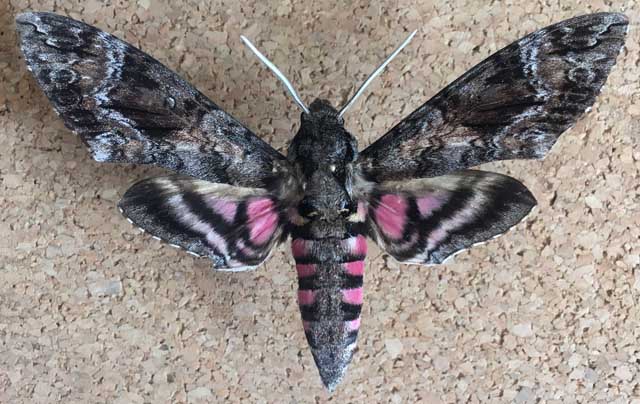
Agrius cingulata, Metcalfe County, Kentucky,
July 17, 2013, courtesy of Derek Bridgehouse
According to Tony Pittaway, Agrius cingulata "differs from A. convolvuli in having bright pink abdominal 'ribs', as
opposed to the reddish pink of A. convolvuli, and pink at base of hindwing. In f. decolora Edwards, the 'pink ribs' are pale
pinkish white, almost white."
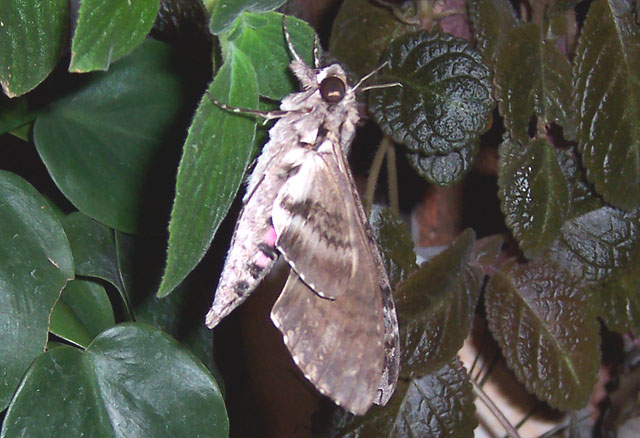
Agrius cingulata in unusual pose, October 6, 2004, courtesy of Phillis in Louisiana.
"Extra-limital range: The tropics and subtropics of the New World, and the Galapagos and Hawaiian Islands.
As a migrant, Agrius cingulata flies north to Canada, south to Patagonia and the Falkland Islands and,
occasionally, to western Europe. A. cingulata has recently established itself in the Cape Verde Islands west of Senegal, West
Africa (Bauer & Traub, 1980), adults having arrived, presumably, from Brazil."
"Specimens have been found in England (Barrett, 1895) and on ships off the French coast."
Typical resting pose of the Sphingini is displayed to the right.
Photo courtesy of Paolo Mazzei.
See images from the desert of northern Chile
courtesy of Carolina Guzmán Cardenas. |
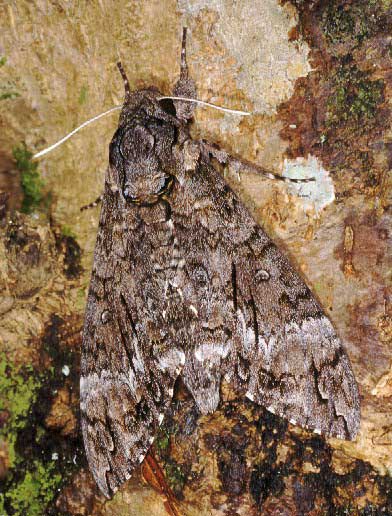 |
In Bolivia, specimens have been taken in "Santa Cruz: Andrés Ibáñez, Potrerillos del Güendá; Florida, Pampa Grande; Ichilo, Buena Vista;
La Paz: Murillo Zongo Cuticucho; Cota Cota; La Paz: La Paz; Santa Cruz: Ichilo, Buena Vista, 750m; Cochabamba: Bolivar, Balzapamba; Ceroado: Cochabamba; Chapare,
Yunga del Espíritu Santo; Santa Cruz: Sarah; Sarah, 450m; Warnes." Jean Haxaire.
In French Guiana: Kaw and Coralie, specimens have been taken in November.
Francierlem Oliveira reports a November flight in Extremoz, Rio Grande Do Norte, Brazil.
Frank West confirms them in Peru: Amazonas: Leymebamba; and Guatemala: Suchitepequez: Petulul and Izabal: near Morales;
as well as in Brazil: Bahia: near Camacan and in Rondonia.
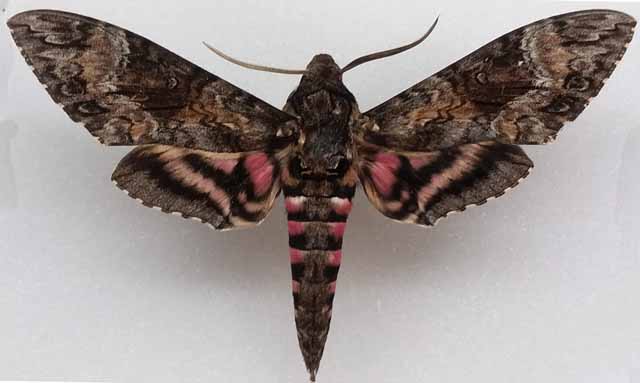
Agrius cingulata, 100mm, Leymebamba, Amazonas, Peru,
November, 2018, 11,000ft. (probably 7700ft/2485m), courtesy of Frank West.
I suspect it flies throughout South and Central America.
Both males and females come to lights.
This species is a very strong flier with strong migration tendencies and can also probably be found just about everywhere in Central and South America
and in the Caribbean Islands.
Argentina:
Buenos Aires, Cordoba, Jujuy, La Pampa, La Rioja, Misiones, Salta,
Santa Fe, Tucuman, Chaco, Formosa and Corrientes (JRR).
Paraguay: Asuncion; (Boqueron, Presidente Hayes,
Concepcion, Amambay, San Pedro, Canindeyu, Cordillera, Guaira, Caaguazu,
Alto Parana, Central, Paraguari (pybio)) and (probably
Caazapa, Itapua, Misiones, Neembucu (WO?)).
In Venezuela it has been reported in Anzoategui, Aragua, Falcon, Lara, Portuguesa, Sucre, Tachira, Amazonas (RM), Yaracuy.
In Brazil it is reported from Roraima to Rio Grande do Nort and Minas Gerais (LV); Maranhao (JH).
Mexico: Yucatan (PH), probably throughout Mexico.
Belize: Corozol, Cayo, Stan Creek, Toledo.
Nicaragua: Esteli, Matagalpa, Chinandega, Leon,
Managua, Masaya, Granada, Rivas, Rio San Juan, Isla de Ometepe,
probably everywhere;
Costa Rica: Guanacaste, Puntarenas, San Jose,
Alajuela, Lemon, Heredia, Carthage.
Leif Gabrielsen reports an October flight in Ecuador: Pichincha: Bella Vista Lodge.
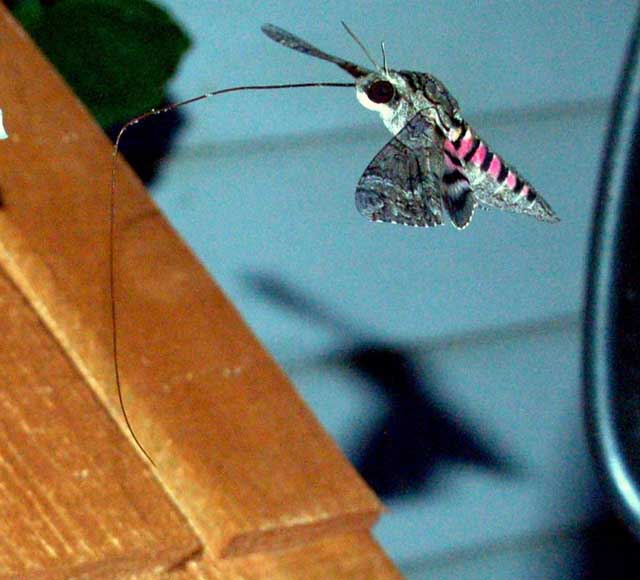
Agrius cingulata, Clarksville, Clark County, Indiana,
proboscis in full view, September, 2010,
courtesy of Albert Schneider via Dan Davison.
The extra long proboscis or feeding tube, enables this species to successfully nectar on deep throated blooms.
Visit a beautiful series of
photos of
Agrius cingulata from Vicksburg, Mississippi, courtesy of
Paul Ingram.
Visit Agrius cingulata, Itanhandu, Minas Gerais, Brazil, November 8, 2009, courtesy of Larry Valentine.
Visit Agrius cingulata adult and sweet potato match, Dallas, Collin County, Texas,
courtesy of Robert McClure;
combined with comments by Bill Oehlke; and larva, courtesy of David Bygott.
Visit Agrius cingulata, Extremoz, Rio Grande do Norte, Brazil, June 4, 2016, November 6, 2016, courtesy of Francierlem Oliveira.
Visit Agrius cingulata, Long Key Nature Center, Broward County, Florida, June 23, 2013, Kelli Whitney.
Visit Agrius cingulata, Hawaii: Maui: Kahului; July 13, 2014, Robert Oswald.
Visit Agrius cingulata, Yucatan, Mexico, August 17, 2011, Paul Hoekstra.
Visit Agrius cingulata, Puerto Ayacucho, Amazonas, Venezuela, August 19, 2018, Renato Mattei.
Visit Agrius cingulata, Ocean City, Worcester County, Maryland, September 19, 2011, courtesy of Eric and Jerome Klun
Visit Agrius cingulata, Old Bridge, Middlesex County, New Jersey, September 9, 2011, David Moskowitz.
Visit Agrius cingulata, La Union del Toachi, Pichincha, Ecuador, November, 1988, Hubert Mayer.
Visit Agrius cingulata, Guatemala and Brazil, Frank West.
FLIGHT TIMES:
Agrius cingulata adults fly as a single brood in most of the U.S. from June-October, but there are
several flights throughout the year in Florida and Louisiana. In Costa Rica, adults have been taken every month of the year. In Bolivia,
adults have been taken in January, March-April, July-August, and October-December.
Ezequiel Nunez Bustos confirms a November flight in Misiones, Argentina.
This species is a strong migrant and adults nectar from deep-throated flowers including moonflower
(Calonyction aculeatum), morning glory (Convolvulus), honey suckle (Lonicera) and petunia
(Petunia species). Sandra S. Todd writes, "I live in Blackstone, VA. The flower that this insect seems to love is the
moonflower which is in the family of the morning glory. It blooms at night. [This picture was] taken around 6 pm."
| 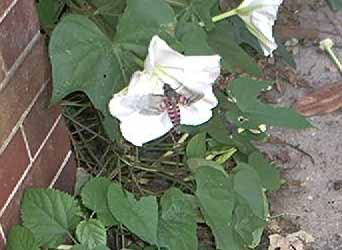 |
James P. Tuttle in The Hawk Moths of North America
indicates that cultivated lily (Crinum),
bouncing bet (Saponaria officinalis), and ornamental
tobacco (Nicotiana) are also popular nectar sources.
In the western Palaearctic all records have been from mid-August to mid-October.
ECLOSION:
Pupae probably wiggle to surface from
subterranean chambers just prior to eclosion.
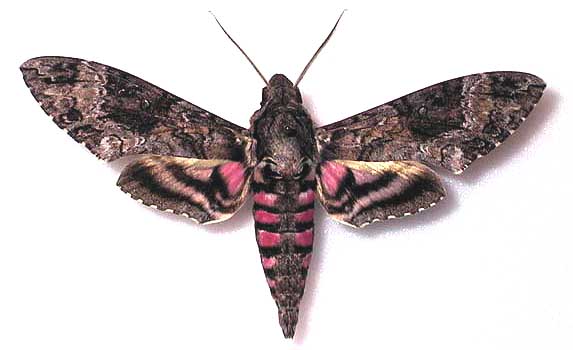
Pink-spotted hawkmoth by Dallas County Lepidopterists' Society.
SCENTING AND MATING:
Females call in the males with a
pheromone released from a gland at the tip of the abdomen.
EGGS, LARVAE, PUPAE:
Eggs are
translucent, nearly spherical and about 1 mm in diameter.
They have a slightly slightly greenish tint.
The first instar of the sweetpotato hornworm has a white body and a black anal horn. Later instars are basically green or brown with
prominent, slanted black markings on each side of the body and a black anal horn. The head is also green or brown with three dark
stripes on each side.
In instars one through four the anal horn is "stiff", but in the fourth instar it droops toward the rear.
Visit
Agrius cingulata, fourth and fifth instars, Georgetown, Williamson County, Texas,
feeding a cypress vine (Quamoclit pennata), August 25-28, 2008, courtesy of Jill Burrows.
Larvae feed both night and day, reach 90-100 mm at maturity and have at least three colour morphs: usually green, brown or yellow.
Larvae feed on plants in the Convolvulaceae family, especially Ipomoea batatas (sweet potato) and
in the Solanaceae family, especially (Datura) (jimsonweed) and related plants in the Americas. The larvae are frequently
regarded as pests in the southern states.
Image courtesy of Michael Singer. (copyright) |
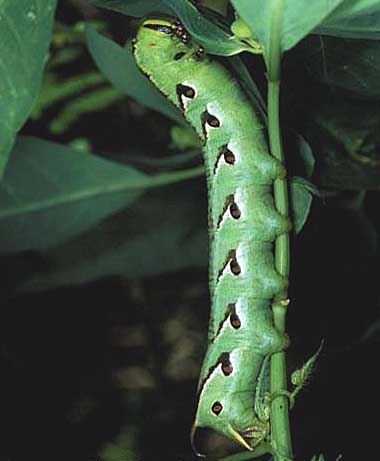 |
Pierre A. Plauzoles writes, "You list Datura spp as hosts. First off, the species to which you are refering is probably
Datura innoxia, formerly known under the name Datura meteloides. It should, however, be noted that there
is some doubt on Agrius cingulata's use of this host. Again here, the doubt may or may not be justified.
"Additionally, rather than being a member of the sweet potato family, it is one of the Solanaceae, known under the common name jimsonweed
(sometimes jimson weed).
" I have heard that this plant is one of those smoked by Native Americans in a large portion of the United States for cermonial
purposes; I have also heard that it contains hallucinogens in the sap and in the foliage -- in fact, possibly in all parts of the
plant. I just don't know enough about it to say exactly what the plant's characteristics are."
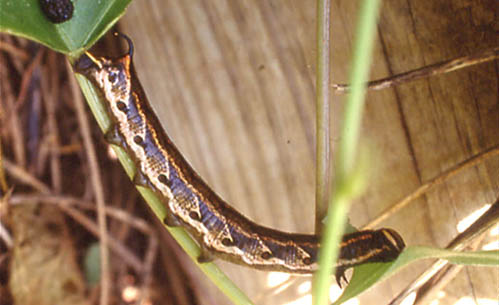 |
In Costa Rica, Dan Janzen lists Merremia umbellata and
Convolvulus nodiflorus as
larval hosts. In Florida larvae have been found on moonflower vine
(Ipomoea alba)Larva to left, from Bexar, Texas, courtesy of Terry Doyle, is on
Ipomaea violaceae. Larvae show considerable variation. |

Dark colour morph
courtesy of Dan Janzen.
Visit Agrius cingulata light brown larval form.
The reddish-brown pupa is 15 mm wide and 55--64 mm long, and the proboscis
reaches half-way down the wings before reflexing under and ending in a 'bulb' which touches the case near the head,
suggesting a pitcher-handle-like appearance. Moths eclose in as little as three weeks after pupation in the tropics.
Larvae are subject to parasitization by Microplitis espinachi and Microplitis espinachi of the Braconidae
family and by Metavoria sp. 1
of the Tachinidae family.
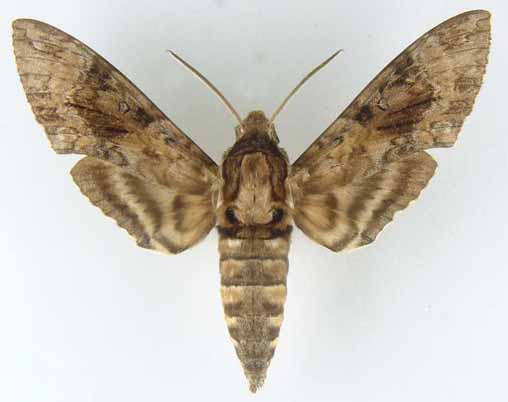
Agrius cingulata var.
decolora H. Edwards, 1882, courtesy of Vernon Brou.
The following hosts are reported from the Galapagos Islands:
Ipomoea pes-caprae, Ipomoea habeliana, Ipomoea nil, Ipomoea triloba and Stictocardia tilifolia.
From Southern Texas, Cat Traylor reports, this one "was chowing down on my yellow morning glories (Ipomoea ochracea)."
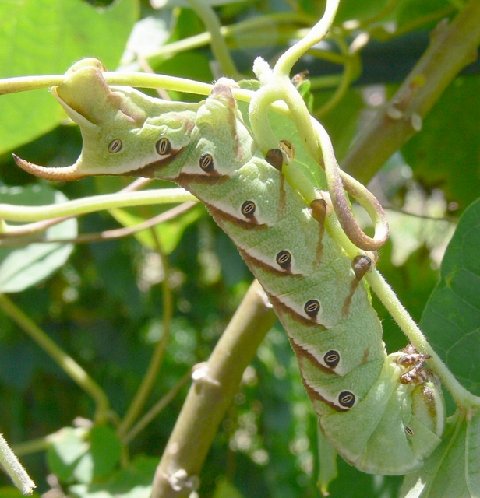
Agrius cingulata on Ipomoea ochracea, courtesy of Cat Traylor.
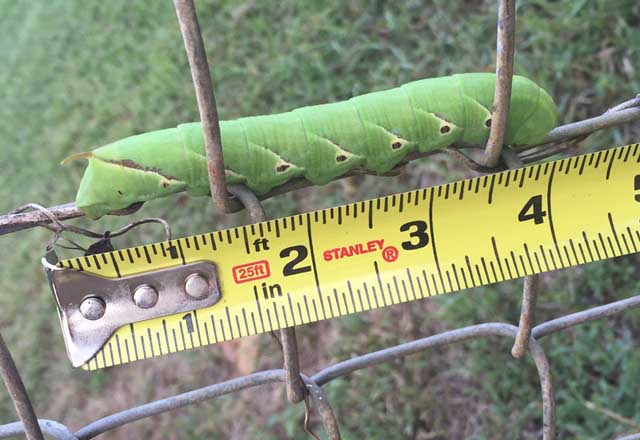
Agrius cingulata fifth instar, Pearl Harbor, Oahu, Hawaii,
July 31, 2015, couirtesy of Deanna H., via Daniel Marlos.
Return to U. S.A. Table
Return to Sphingidae Index
Return to Sphingini Tribe
Use your browser "Back" button to return to the previous page.
This site has been created by Bill Oehlke. Comments, suggestions and/or additional information are welcomed by Bill.
Enjoy one of nature's wonderments: Live Saturniidae (Giant Silkmoth) cocoons.
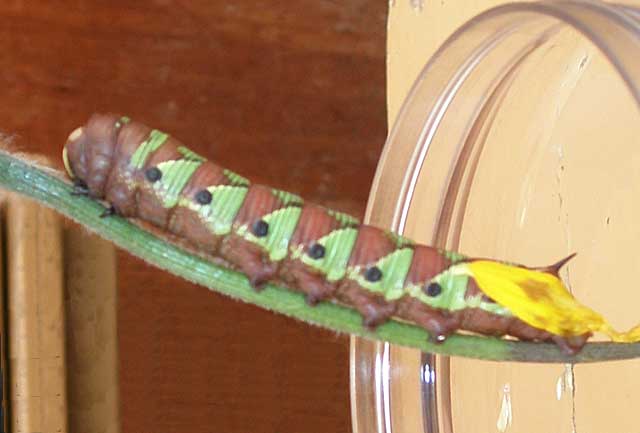
Agrius cingulata fifth instar, San Mateo Cuanala, Puebla, Mexico,
October 9, 2013, found by Luis Abraham Salazar, photographed by Ryan Nielsen
via contact from Tim Olson.
 | 
Show appreciation for this site by clicking on flashing butterfly to the left.
The link will take you to a page with links to many insect sites. |
This website has been created and is maintained by Bill Oehlke without government or institutional financial assistance. All expenses, ie., text reference
support material, webspace rental from Bizland, computer repairs/replacements, backups systems, software for image adjustments (Adobe Photoshop; L-View),
ftp software, anti-virus protection, scanner, etc. are my own.
I very much appreciate all the many images that have been sent to me, or of which I have been granted permission to copy and post from other websites.
All images on this site remain the property of respective photographers.
If you would like to contribute to the maintenance of this website by sending a contribution to
Bill Oehlke
Box 476
155 Peardon Road
Montague, Prince Edward Island, C0A1R0
Canada
Your donation would be much appreciated and would be used for
1) paying for webspace rental;
2) paying for computer maintenance and software upgrades;
3) purchases of additional text reference material (journals and books) in an effort to stay current with new species;
4) helping to pay my daughter's tuition (completed spring 2013).
I also hope to expand the North American Catocala site as well as the Sphingidae of the Americas site, to worldwide sites, and that
will require additional funds for reference materials, etc. Both of those site are linked from your WLSS homepage.
If you are mailing a check from USA, please use $0.85 postage ($1.25 is 2015 rate, check first with post office as rates seem to increase annually).
Donations can also be made through Paypal via the button below.
Donations are not required to maintain your standing as a WLSS member, nor do they gain you any preferencial treatment with regard to livestock and/or
supplies (sleeves), compared to other WLSS members. All WLSS members get first crack at my annual offerings and get an approximate discount of 10% as
compared to non-members.
I do usually ask donors if they have any special requests for material on WLSS, and I try to accomodate when appropriate or within my ability to do so.
















